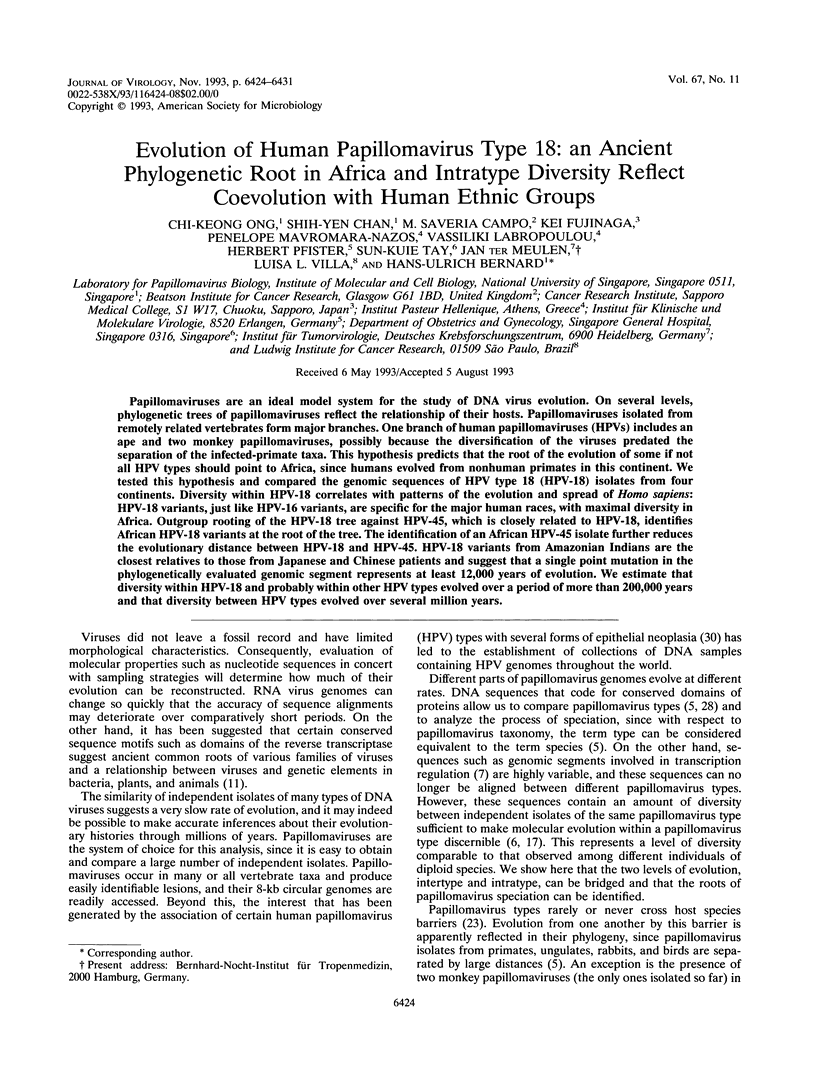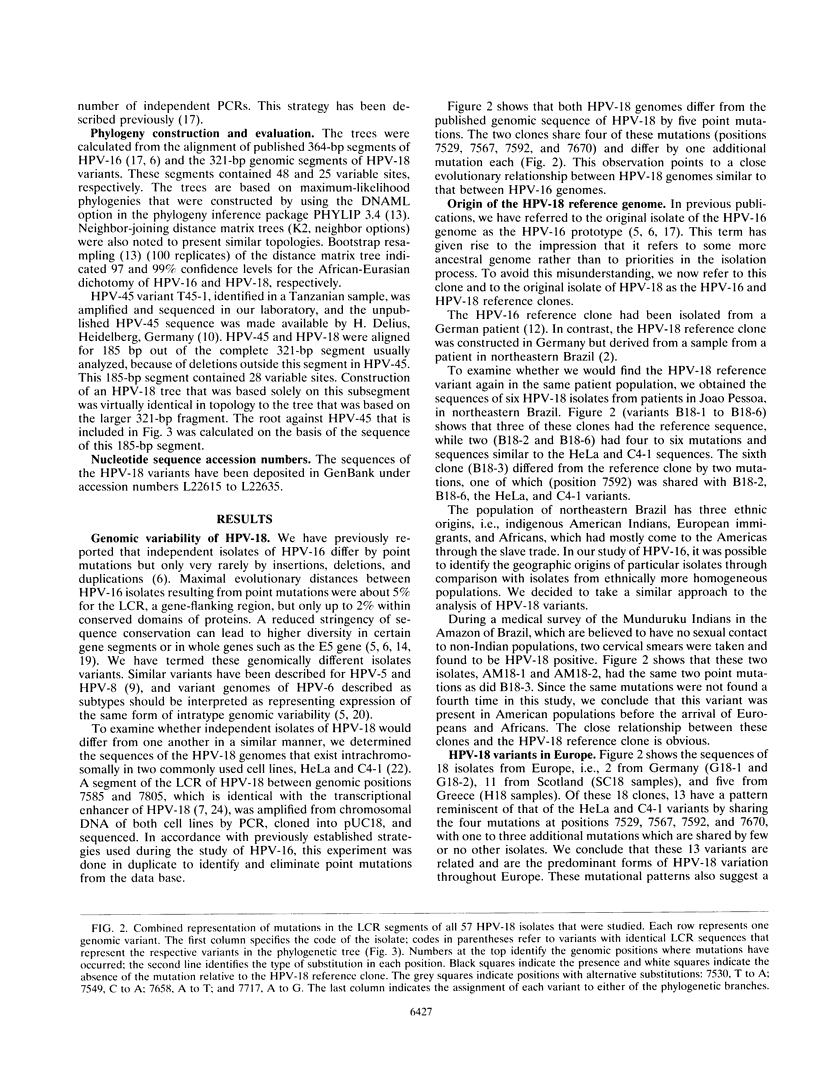Abstract
Papillomaviruses are an ideal model system for the study of DNA virus evolution. On several levels, phylogenetic trees of papillomaviruses reflect the relationship of their hosts. Papillomaviruses isolated from remotely related vertebrates form major branches. One branch of human papillomaviruses (HPVs) includes an ape and two monkey papillomaviruses, possibly because the diversification of the viruses predated the separation of the infected-primate taxa. This hypothesis predicts that the root of the evolution of some if not all HPV types should point to Africa, since humans evolved from nonhuman primates in this continent. We tested this hypothesis and compared the genomic sequences of HPV type 18 (HPV-18) isolates from four continents. Diversity within HPV-18 correlates with patterns of the evolution and spread of Homo sapiens: HPV-18 variants, just like HPV-16 variants, are specific for the major human races, with maximal diversity in Africa. Outgroup rooting of the HPV-18 tree against HPV-45, which is closely related to HPV-18, identifies African HPV-18 variants at the root of the tree. The identification of an African HPV-45 isolate further reduces the evolutionary distance between HPV-18 and HPV-45. HPV-18 variants from Amazonian Indians are the closest relatives to those from Japanese and Chinese patients and suggest that a single point mutation in the phylogenetically evaluated genomic segment represents at least 12,000 years of evolution. We estimate that diversity within HPV-18 and probably within other HPV types evolved over a period of more than 200,000 years and that diversity between HPV types evolved over several million years.
Full text
PDF







Selected References
These references are in PubMed. This may not be the complete list of references from this article.
- Barinaga M. "African Eve" backers beat a retreat. Science. 1992 Feb 7;255(5045):686–687. doi: 10.1126/science.1738842. [DOI] [PubMed] [Google Scholar]
- Boshart M., Gissmann L., Ikenberg H., Kleinheinz A., Scheurlen W., zur Hausen H. A new type of papillomavirus DNA, its presence in genital cancer biopsies and in cell lines derived from cervical cancer. EMBO J. 1984 May;3(5):1151–1157. doi: 10.1002/j.1460-2075.1984.tb01944.x. [DOI] [PMC free article] [PubMed] [Google Scholar]
- Cavalli-Sforza L. L., Menozzi P., Piazza A. Demic expansions and human evolution. Science. 1993 Jan 29;259(5095):639–646. doi: 10.1126/science.8430313. [DOI] [PubMed] [Google Scholar]
- Cavalli-Sforza L. L., Minch E., Mountain J. L. Coevolution of genes and languages revisited. Proc Natl Acad Sci U S A. 1992 Jun 15;89(12):5620–5624. doi: 10.1073/pnas.89.12.5620. [DOI] [PMC free article] [PubMed] [Google Scholar]
- Chan S. Y., Bernard H. U., Ong C. K., Chan S. P., Hofmann B., Delius H. Phylogenetic analysis of 48 papillomavirus types and 28 subtypes and variants: a showcase for the molecular evolution of DNA viruses. J Virol. 1992 Oct;66(10):5714–5725. doi: 10.1128/jvi.66.10.5714-5725.1992. [DOI] [PMC free article] [PubMed] [Google Scholar]
- Chan S. Y., Ho L., Ong C. K., Chow V., Drescher B., Dürst M., ter Meulen J., Villa L., Luande J., Mgaya H. N. Molecular variants of human papillomavirus type 16 from four continents suggest ancient pandemic spread of the virus and its coevolution with humankind. J Virol. 1992 Apr;66(4):2057–2066. doi: 10.1128/jvi.66.4.2057-2066.1992. [DOI] [PMC free article] [PubMed] [Google Scholar]
- Chong T., Chan W. K., Bernard H. U. Transcriptional activation of human papillomavirus 16 by nuclear factor I, AP1, steroid receptors and a possibly novel transcription factor, PVF: a model for the composition of genital papillomavirus enhancers. Nucleic Acids Res. 1990 Feb 11;18(3):465–470. doi: 10.1093/nar/18.3.465. [DOI] [PMC free article] [PubMed] [Google Scholar]
- Cole S. T., Danos O. Nucleotide sequence and comparative analysis of the human papillomavirus type 18 genome. Phylogeny of papillomaviruses and repeated structure of the E6 and E7 gene products. J Mol Biol. 1987 Feb 20;193(4):599–608. doi: 10.1016/0022-2836(87)90343-3. [DOI] [PubMed] [Google Scholar]
- Deau M. C., Favre M., Orth G. Genetic heterogeneity among human papillomaviruses (HPV) associated with epidermodysplasia verruciformis: evidence for multiple allelic forms of HPV5 and HPV8 E6 genes. Virology. 1991 Oct;184(2):492–503. doi: 10.1016/0042-6822(91)90419-c. [DOI] [PubMed] [Google Scholar]
- Doolittle R. F., Feng D. F., Johnson M. S., McClure M. A. Origins and evolutionary relationships of retroviruses. Q Rev Biol. 1989 Mar;64(1):1–30. doi: 10.1086/416128. [DOI] [PubMed] [Google Scholar]
- Dürst M., Gissmann L., Ikenberg H., zur Hausen H. A papillomavirus DNA from a cervical carcinoma and its prevalence in cancer biopsy samples from different geographic regions. Proc Natl Acad Sci U S A. 1983 Jun;80(12):3812–3815. doi: 10.1073/pnas.80.12.3812. [DOI] [PMC free article] [PubMed] [Google Scholar]
- Gessain A., Boeri E., Yanagihara R., Gallo R. C., Franchini G. Complete nucleotide sequence of a highly divergent human T-cell leukemia (lymphotropic) virus type I (HTLV-I) variant from melanesia: genetic and phylogenetic relationship to HTLV-I strains from other geographical regions. J Virol. 1993 Feb;67(2):1015–1023. doi: 10.1128/jvi.67.2.1015-1023.1993. [DOI] [PMC free article] [PubMed] [Google Scholar]
- Ho L., Chan S. Y., Chow V., Chong T., Tay S. K., Villa L. L., Bernard H. U. Sequence variants of human papillomavirus type 16 in clinical samples permit verification and extension of epidemiological studies and construction of a phylogenetic tree. J Clin Microbiol. 1991 Sep;29(9):1765–1772. doi: 10.1128/jcm.29.9.1765-1772.1991. [DOI] [PMC free article] [PubMed] [Google Scholar]
- Hoffecker J. F., Powers W. R., Goebel T. The colonization of beringia and the peopling of the new world. Science. 1993 Jan 1;259(5091):46–53. doi: 10.1126/science.259.5091.46. [DOI] [PubMed] [Google Scholar]
- Icenogle J. P., Sathya P., Miller D. L., Tucker R. A., Rawls W. E. Nucleotide and amino acid sequence variation in the L1 and E7 open reading frames of human papillomavirus type 6 and type 16. Virology. 1991 Sep;184(1):101–107. doi: 10.1016/0042-6822(91)90826-w. [DOI] [PubMed] [Google Scholar]
- Mounts P., Kashima H. Association of human papillomavirus subtype and clinical course in respiratory papillomatosis. Laryngoscope. 1984 Jan;94(1):28–33. doi: 10.1002/lary.5540940106. [DOI] [PubMed] [Google Scholar]
- Naghashfar Z. S., Rosenshein N. B., Lorincz A. T., Buscema J., Shah K. V. Characterization of human papillomavirus type 45, a new type 18-related virus of the genital tract. J Gen Virol. 1987 Dec;68(Pt 12):3073–3079. doi: 10.1099/0022-1317-68-12-3073. [DOI] [PubMed] [Google Scholar]
- Reuter S., Delius H., Kahn T., Hofmann B., zur Hausen H., Schwarz E. Characterization of a novel human papillomavirus DNA in the cervical carcinoma cell line ME180. J Virol. 1991 Oct;65(10):5564–5568. doi: 10.1128/jvi.65.10.5564-5568.1991. [DOI] [PMC free article] [PubMed] [Google Scholar]
- Schwarz E., Freese U. K., Gissmann L., Mayer W., Roggenbuck B., Stremlau A., zur Hausen H. Structure and transcription of human papillomavirus sequences in cervical carcinoma cells. Nature. 1985 Mar 7;314(6006):111–114. doi: 10.1038/314111a0. [DOI] [PubMed] [Google Scholar]
- Swift F. V., Bhat K., Younghusband H. B., Hamada H. Characterization of a cell type-specific enhancer found in the human papilloma virus type 18 genome. EMBO J. 1987 May;6(5):1339–1344. doi: 10.1002/j.1460-2075.1987.tb02373.x. [DOI] [PMC free article] [PubMed] [Google Scholar]
- Van Ranst M., Fuse A., Fiten P., Beuken E., Pfister H., Burk R. D., Opdenakker G. Human papillomavirus type 13 and pygmy chimpanzee papillomavirus type 1: comparison of the genome organizations. Virology. 1992 Oct;190(2):587–596. doi: 10.1016/0042-6822(92)90896-w. [DOI] [PubMed] [Google Scholar]
- Van Ranst M., Kaplan J. B., Burk R. D. Phylogenetic classification of human papillomaviruses: correlation with clinical manifestations. J Gen Virol. 1992 Oct;73(Pt 10):2653–2660. doi: 10.1099/0022-1317-73-10-2653. [DOI] [PubMed] [Google Scholar]
- Vigilant L., Stoneking M., Harpending H., Hawkes K., Wilson A. C. African populations and the evolution of human mitochondrial DNA. Science. 1991 Sep 27;253(5027):1503–1507. doi: 10.1126/science.1840702. [DOI] [PubMed] [Google Scholar]
- zur Hausen H. Viruses in human cancers. Science. 1991 Nov 22;254(5035):1167–1173. doi: 10.1126/science.1659743. [DOI] [PubMed] [Google Scholar]


